Future of Space Market : Emerging Technologies, Evolving Disruptions, Future Outlook and Growth Opportunities to 2064
This study presents the future prospects in the space industry, for space market participants and non-space market participants. The analysis covers major segments across upstream, midstream and downstream, capturing 50+ megatrends where each megatrend is analyzed to identify future predictions, related technological evolutions that will lead the industry to those future states and the consequent growth opportunities for space and non-space market participants. The study also presents future scenarios and recent developments across the segments while capturing the key market participants involved in each market segment. This study has covered over 650 space and non-space market participants to boil down the ongoing developments to future predictions to further define the demand they will create for various products and services. Specific focus on space colonization, militarization and in-space economy has been given within this study. If you are someone who wants to look into the future of space to identify opportunities to allocate resources against, this comprehensive study will be a great place to begin before you proceed for further deep dive investigations.
Key questions the study will answer are:
- What are the major opportunity areas in space industry and when will they materialize?
- Who are the key disruptors/fast-movers in the space industry and how are they leading over their peers?
- What are key technological evolutions where startups can contribute?
- What are the key startups that can be valuable acquisition targets for established incumbents?
- What will drive manned deep space missions to evolve into human settlement? What will be the key developments needed for the space industry to progress to that point?
- How will space militarization create opportunities for space market participants?
- What are the opportunity areas within the scope of in-space economy?
Space industry: by 2064
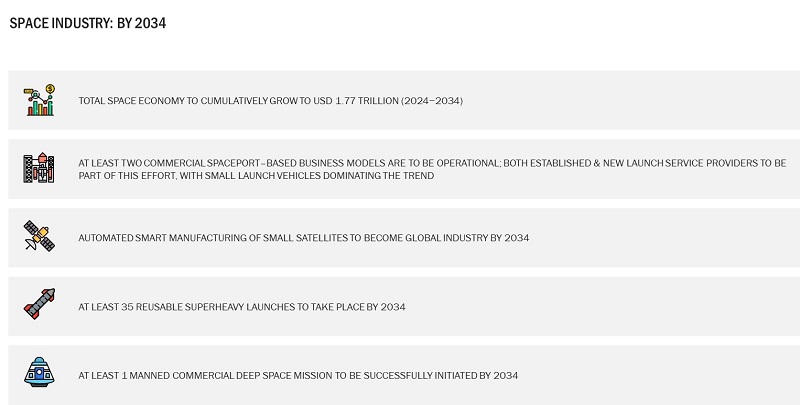
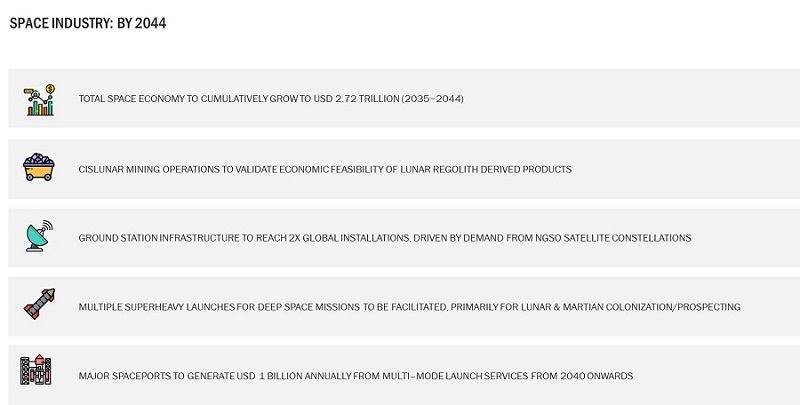
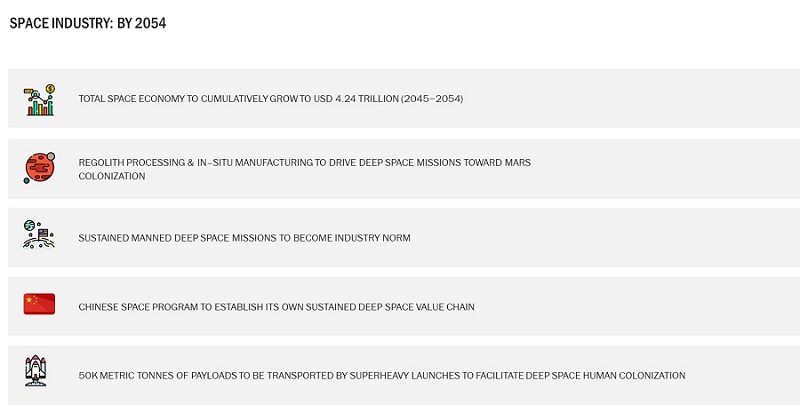
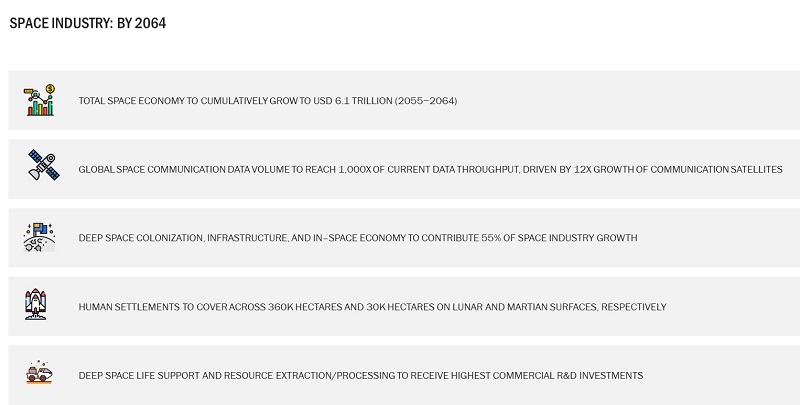
Evolving Space Ecosystem
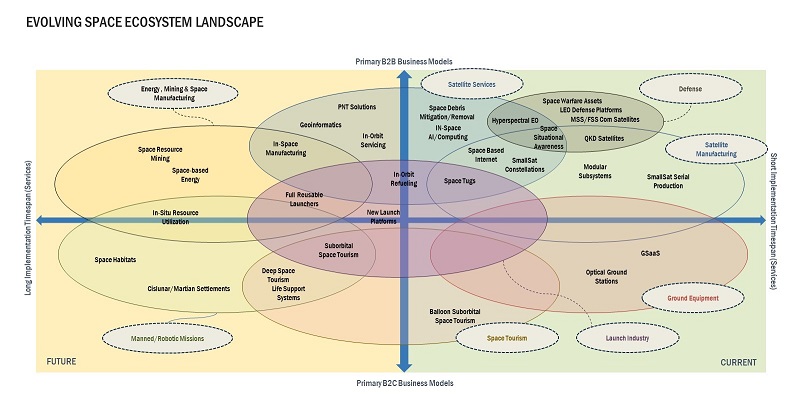
Recent Developments:
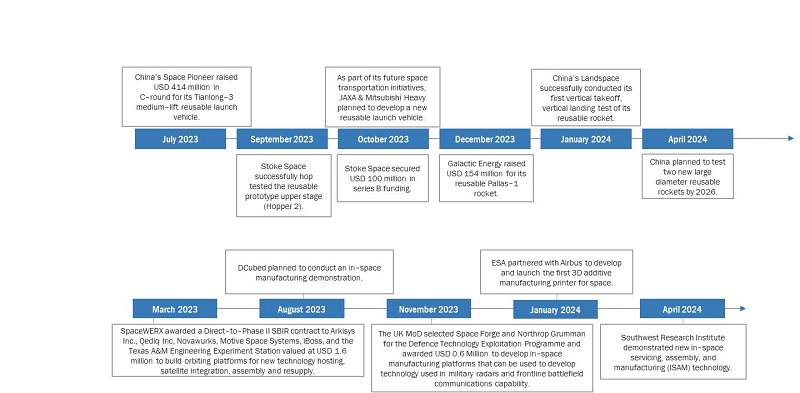
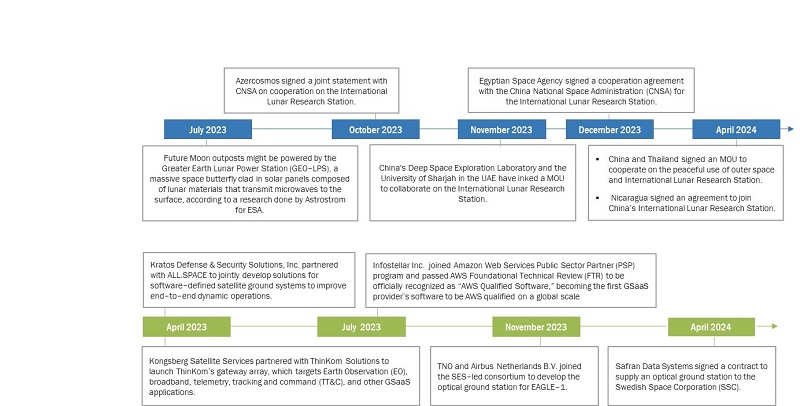

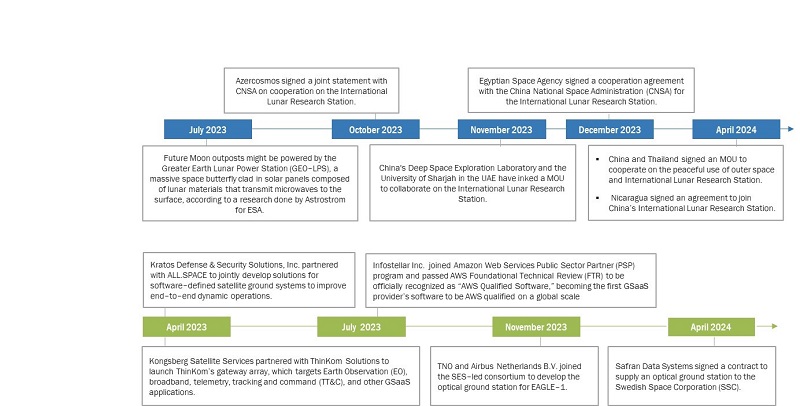
Key questions the study will answer are:
What are the major opportunity areas in space industry and when will they materialize?
Major opportunity areas include Dedicated Reusable Launch Vehicle Cadence, Lunar Resource Utilization, In-Space Manufacturing, Space Communication and Hyperspectral Earth Observation. Lunar Resource Utilization is expected to materialize by the 2040s, while Hyperspectral Earth Observation and 6G Space Communication will likely mature by the 2030s.
Who are the key disruptors/fast-movers in the space industry and how are they leading over their peers?
A list of 30 fast movers across the space ecosystem value chain has been captured, scoped from 650+ market participants. These companies are front-runners in disruptions driving the future, across their respective segments.
What are key technological evolutions where startups can contribute?
Startups can contribute to AI-driven Space Communication Infrastructure, Quantum Communication Satellites, Cognitive EO Intelligence, and Edge Processing in Earth Observation. These technologies are critical for improving space communication, data processing, and decision-making in real-time.
What are the key startups that can be valuable acquisition targets for established incumbents?
Valuable acquisition targets are scoped due to their specialized technologies and market positioning, from the overall captured ecosystem, targeting specific segments/specialties.
What will drive manned deep space missions to evolve into human settlement? What will be the key developments needed for the space industry to progress to that point?
Manned deep space missions will evolve into human settlements through advancements in life support systems, in-situ resource utilization (ISRU), and habitat construction technologies. Key developments include the establishment of permanent bases on the Moon and Mars, sustainable energy solutions, and closed-loop ecosystems.
How will space militarization create opportunities for space market participants?
Space militarization will create opportunities in Space-Based Electronic & Cyber Warfare Systems, Next Generation Space Command & Control, and PNT Solutions. These will drive demand for advanced satellite networks, secure communication systems, and resilient infrastructure for defense purposes.
What are the opportunity areas within the scope of in-space economy?
Opportunity areas include In-Space Manufacturing Facilities, Commercial Space Station Services, Lunar Outposts, and Regolith Processing. These segments will enable the creation of self-sustaining space habitats, resource extraction, and the development of infrastructure to support long-term human presence in space.
To speak to our analyst for a discussion on the above findings, click Speak to Analyst

The report meticulously examines major segments spanning the upstream, midstream, and downstream sectors, identifying and analyzing 57 key megatrends. Each megatrend is thoroughly assessed to predict future industry states, delineate the technological advancements driving these changes, and highlight the resulting growth opportunities for both space-centric and broader market players.
This forward-looking study presents future scenarios and recent developments within each segment, detailing the pivotal role of over 650 market participants in shaping the industry's trajectory. Special emphasis is placed on the transformative areas of space colonization, militarization, and the burgeoning in-space economy. By boiling down ongoing developments into actionable future predictions, this report defines the anticipated demand for various products and services, offering a roadmap for resource allocation and strategic planning.
The study also integrates technological readiness level (TRL) assessments and innovation diffusion models to evaluate the maturation timelines of key technologies driving these megatrends. By correlating these technological trajectories with market potential and competitive landscape analysis, the study delineates specific growth opportunities for space and non-space market participants. The methodology is designed to distill complex, multi-faceted developments into clear, strategic insights, enabling stakeholders to anticipate future demand for products and services and strategically allocate resources to capitalize on emerging opportunities.
For those seeking to navigate the future of space and identify lucrative opportunities, this exhaustive study serves as an essential foundation for further detailed investigations.
Secondary Research
The secondary research for the "Future of Space" study involved an extensive review of existing literature, including industry reports, peer-reviewed journals, market intelligence, patent databases, and government publications. This process gathered a comprehensive dataset on current trends, technological advancements, market dynamics, and regulatory frameworks across the space industry. By analyzing and synthesizing this information, cross-referencing data points are identified in emerging megatrends and potential growth areas.
Primary Research
In the primary research process, various sources from the supply and demand sides were interviewed to obtain qualitative and quantitative information on the market. The primary sources from the supply side included industry experts such as chief X officers (CXOs), vice presidents (VPs), directors, regional managers, and business development teams , system integrators and distributors.
Extensive primary research was conducted after obtaining information about the current scenario of the ammunition market through secondary research. Several primary interviews were conducted with market experts from both demand and supply sides across major countries of North America, Europe, Asia Pacific, the Middle East, Latin America, and Africa. This primary data was collected through questionnaires, emails, and telephonic interviews.
Market Size Estimation
Both top-down and bottom-up approaches were used to estimate and validate the size of market segments across the space industry. The research methodology used to estimate the market size included the following details:
- All possible parameters that affect the markets covered in this research study were accounted for, viewed in extensive detail, verified through secondary research, and analyzed to obtain the final quantitative and qualitative data on the future of respective market segments. This data was consolidated, enhanced with detailed inputs, analyzed by MarketsandMarkets, and presented in this report.
- All percentage shares, splits, and breakdowns were determined using secondary sources and verified through primary sources.
Market size estimation methodology: Bottom-up Approach

Market size estimation methodology: Top-Down Approach

Data Triangulation
The total market was split into several segments and subsegments. The data triangulation and market breakdown procedures explained below were implemented wherever applicable to complete the overall market engineering process and arrive at the exact statistics for various market segments and subsegments.
The data was triangulated by studying various factors and trends from both the demand and supply sides. Along with this, the market size was validated using both top-down and bottom-up approaches. The following figure indicates the market breakdown structure and data triangulation procedure that was implemented in the market engineering process.
Report Objectives
- To Identify Key Megatrends: The report aims to pinpoint and analyze 57 megatrends across the space industry, covering upstream, midstream, and downstream segments, to forecast their impact on future market dynamics.
- Analyze Technological Evolution: The report seeks to explore the technological advancements that will drive the space industry forward, detailing how these innovations will shape future capabilities and market opportunities.
- Forecast Future Market Scenarios: By examining current trends and emerging technologies, the report aims to predict future scenarios in the space industry, providing stakeholders with a strategic vision of potential developments.
- Map Growth Opportunities: One of the primary objectives is to identify and quantify the growth opportunities for both space and non-space market participants, based on future technological and market trends.
- Evaluate Market Segments: The report is designed to provide a detailed analysis of 10 major segments within the space industry, assessing their current state and future potential in driving industry growth.
- Assess Competitive Landscape: The study aims to evaluate the competitive landscape, identifying key players, their strategic positions, and how they might influence or be influenced by future industry trends.
- Understand Industry Interdependencies: The report seeks to analyze the interdependencies between different segments of the space industry, understanding how developments in one area might impact others.
- Guide Strategic Resource Allocation: By providing detailed insights into future trends and market demands, the report aims to guide stakeholders in strategically allocating resources to maximize returns on investment.
- Highlight Space Colonization Prospects: The report focuses on the future of space colonization, assessing its feasibility, technological requirements, and potential economic impacts.
- Explore In-Space Economy Dynamics: The study aims to delve into the in-space economy, examining the development of commercial activities in space and their implications for global markets.
- Investigate Militarization of Space: The report seeks to explore the militarization of space, analyzing its future trajectory, key players, and the geopolitical implications for global security.
- Provide Strategic Roadmap: The study aims to deliver a strategic roadmap for market participants, outlining the steps necessary to capitalize on emerging opportunities in the space industry.
- Facilitate Informed Decision-Making: The report is intended to empower stakeholders with the information needed to make informed decisions, particularly in areas of investment, technology development, and market entry strategies.
- Promote Cross-Industry Collaboration: By identifying growth opportunities for non-space participants, the report aims to encourage cross-industry collaboration, fostering innovation and expanding the space market ecosystem.
Available customizations
Along with the market data, MarketsandMarkets offers customizations as per the specific needs of companies. The following customization options are available for the report:
Product Analysis
- Product matrix, which gives a detailed comparison of the product portfolio of each company
Regional Analysis
- Further breakdown of the market segments at country-level
Company Information
- Detailed analysis and profiling of additional market players (up to 5)















Growth opportunities and latent adjacency in Future of Space Market